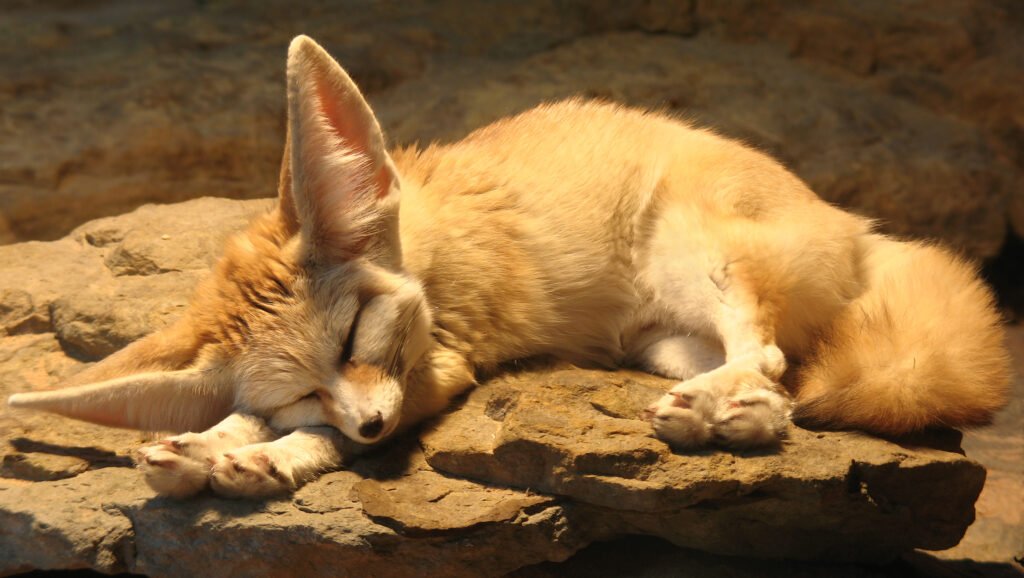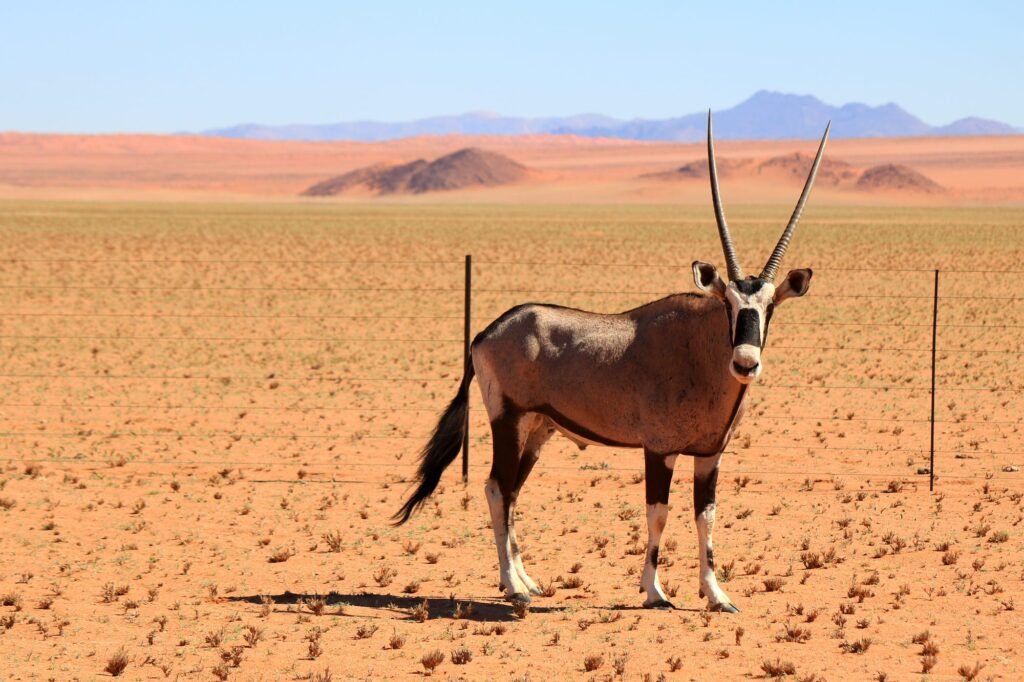Introduction
Deserts are among the harshest environments on Earth, characterized by extreme temperatures, scarce water, and limited vegetation. Yet, despite these unforgiving conditions, many animals not only survive but thrive. From reptiles and mammals to birds and insects, desert animals are equipped with extraordinary adaptations that help them endure the challenges of desert life.
This article explores how desert animals have evolved to cope with their environment, highlighting their physical and behavioral adaptations, examples of iconic species, and the importance of conservation efforts.
Understanding the Desert Environment

Climate and Terrain
Deserts receive less than 250 mm (10 inches) of rainfall annually. Daytime temperatures can soar above 50°C (122°F), while nighttime temperatures may plummet below freezing. The landscape ranges from endless sand dunes to rocky outcrops and sparse shrublands.
Types of Deserts
There are four main types of deserts, each hosting unique wildlife:
- Hot and dry deserts like the Sahara and Sonoran Desert
- Semi-arid deserts such as the Great Basin Desert
- Coastal deserts including the Atacama in Chile
- Cold deserts like the Gobi and parts of Antarctica
Also Read : How To Support Animal Welfare Organizations Effectively
How Desert Animals Survive

Physical Adaptations
Water Conservation
Water is life in the desert, and desert animals have developed ingenious methods of conserving it.
- Camels can lose up to 25% of their body weight in water and still survive, rehydrating quickly when water becomes available.
- Kangaroo rats metabolize moisture from the seeds they eat, allowing them to survive without drinking.
- Fennec foxes have highly efficient kidneys that excrete very little water.
Temperature Regulation
Desert animals often have adaptations to avoid overheating or freezing.
- Large ears in animals like jackrabbits and fennec foxes help dissipate heat.
- Light-colored fur or scales reflect sunlight, reducing heat absorption.
- Some reptiles can alter their skin color slightly to regulate body temperature.
Camouflage
Desert animals tend to have coloring that blends into their environment, helping them avoid predators.
- Lizards and snakes often sport sand-colored patterns.
- Owls and birds of prey are often beige, brown, or white to blend with rocky or sandy backdrops.
Behavioral Adaptations
Nocturnality
Many desert animals are nocturnal, meaning they are active at night when temperatures are cooler.
- Bats, owls, and many rodents forage at night.
- Predators like desert foxes also hunt after sundown to avoid the heat.
Burrowing and Shade-Seeking
To escape extreme heat, many desert animals live in burrows or seek shade during the hottest part of the day.
- Desert tortoises dig underground tunnels where the temperature is significantly cooler.
- Scorpions and snakes often hide beneath rocks or in sand during the day.
Dormancy and Aestivation
Some animals become dormant during the hottest months or during droughts.
- Spadefoot toads bury themselves and remain inactive until the rains return.
- Certain insects and reptiles enter states similar to hibernation to survive heat and food scarcity.
Also Read : The Role Of Animal Nutrition In Enhancing Immune System Function
Iconic Desert Animals and Their Adaptations

Camel (Camelus dromedarius)
Known for their endurance and ability to travel long distances without water, camels are perfectly adapted for desert life. Their humps store fat, which can be converted into energy and water. Camels also have thick eyelashes and closable nostrils to protect against sand.
Fennec Fox (Vulpes zerda)
This small desert fox, native to the Sahara, has enormous ears that help with heat dissipation. Fennec foxes are nocturnal and have thick fur on the soles of their feet to protect them from hot sand.
Kangaroo Rat (Dipodomys spp.)
Kangaroo rats are desert survival experts. They live in underground burrows and rarely, if ever, drink water, obtaining all the moisture they need from seeds. Their kidneys produce extremely concentrated urine to conserve water.
Gila Monster (Heloderma suspectum)
Found in the deserts of the southwestern U.S., the Gila monster is one of the few venomous lizards in the world. It stores fat in its tail and can go for months without food. It spends up to 95% of its life underground.
Sidewinder Snake (Crotalus cerastes)
This rattlesnake has a unique sideways movement that helps it avoid full contact with hot sand. It buries itself beneath the surface during the day and ambushes prey at night.
Desert Tortoise (Gopherus agassizii)
The desert tortoise can store water in its bladder and survive for long periods without drinking. It digs extensive burrows to stay cool and spends most of its time underground.
Meerkat (Suricata suricatta)
Living in groups called mobs or gangs, meerkats are highly social animals. They take turns standing guard while others forage. Meerkats feed on insects, small mammals, and reptiles, and are immune to some snake venoms.
Addax Antelope (Addax nasomaculatus)
Critically endangered, the addax antelope can survive without drinking water for long periods. It feeds on desert grasses and extracts moisture from vegetation. Its light-colored coat reflects sunlight.
Desert Ecosystem and Food Chain

Producers and Consumers
In deserts, cacti, shrubs, and hardy grasses are primary producers. Herbivores like rodents and antelope consume these plants, while carnivores like snakes, foxes, and birds of prey hunt the herbivores. Scavengers such as vultures play a key role in breaking down organic matter.
Role of Decomposers
Insects and microorganisms break down waste and dead matter, recycling nutrients back into the ecosystem, despite the lack of moisture.
Pollination and Seed Dispersal
Bats, birds, and insects are important pollinators in deserts. For example, the lesser long-nosed bat pollinates agave and cactus flowers, while birds help spread seeds through droppings.
Also Read : Urban Wildlife Conservation: Protecting Nature In Growing Cities
Challenges Desert Animals Face
Climate Change
Increasing temperatures and irregular rainfall patterns threaten to disrupt the delicate balance of desert ecosystems. Many species are losing access to already limited water sources.
Habitat Loss
Human activities like mining, agriculture, and urban expansion are destroying or fragmenting desert habitats. Roads and fences disrupt animal migration routes and isolate populations.
Poaching and Illegal Trade
Certain desert animals, such as tortoises and exotic reptiles, are victims of the illegal pet trade, which can decimate wild populations.
Invasive Species
Non-native plants and animals introduced by humans can outcompete native species for food and water, altering the ecosystem.
Also Read : African Safari Animals: Fascinating Facts You Didn’t Know
Conservation Efforts
Protected Areas and Wildlife Reserves
Many countries have established protected areas to conserve desert habitats and their unique wildlife. These include national parks, biosphere reserves, and community-run conservancies.
Captive Breeding and Reintroduction
Programs exist to breed endangered species like the addax antelope and Arabian oryx in captivity and reintroduce them to their native habitats.
Environmental Education
Educating local communities about the value of desert biodiversity helps build support for conservation. Community-based initiatives often encourage sustainable grazing and water use.
Global Collaboration
International organizations like the IUCN and WWF work with governments to protect desert ecosystems, monitor endangered species, and combat illegal wildlife trade.
Also Read : Wildlife Photography: How To Capture The Grace Of Elephants And Giraffes.
Conclusion
Desert animals are some of nature’s most resilient and resourceful creatures. Their remarkable adaptations allow them to live, hunt, and reproduce in some of the planet’s harshest environments. From the moisture-conserving kangaroo rat to the heat-dissipating fennec fox, each species tells a story of evolution, survival, and balance.
As climate change and human activity continue to impact desert ecosystems, it is more important than ever to understand and protect these animals. By learning about their lives and supporting conservation efforts, we can help ensure these masters of survival continue to thrive.
FAQs
What makes desert animals unique?
Desert animals have specialized adaptations such as water conservation, heat regulation, and nocturnal behavior that allow them to survive in extreme temperatures and dry environments.
Are all desert animals nocturnal?
Not all, but many are. Being active at night helps them avoid the intense heat of the day. Some, like reptiles, are crepuscular, meaning they’re active during dawn and dusk.
Do desert animals drink water?
Some do, but many rely on water from their food. For instance, kangaroo rats and some snakes never drink water and survive entirely on metabolic moisture.
How do animals stay cool in the desert?
Animals stay cool by being active at night, burrowing during the day, having reflective body coverings, and using anatomical features like large ears to dissipate heat.
Why is desert animal conservation important?
Desert ecosystems are fragile and home to unique biodiversity. Conservation ensures these species and their habitats are protected from threats like climate change, habitat loss, and illegal trade.





